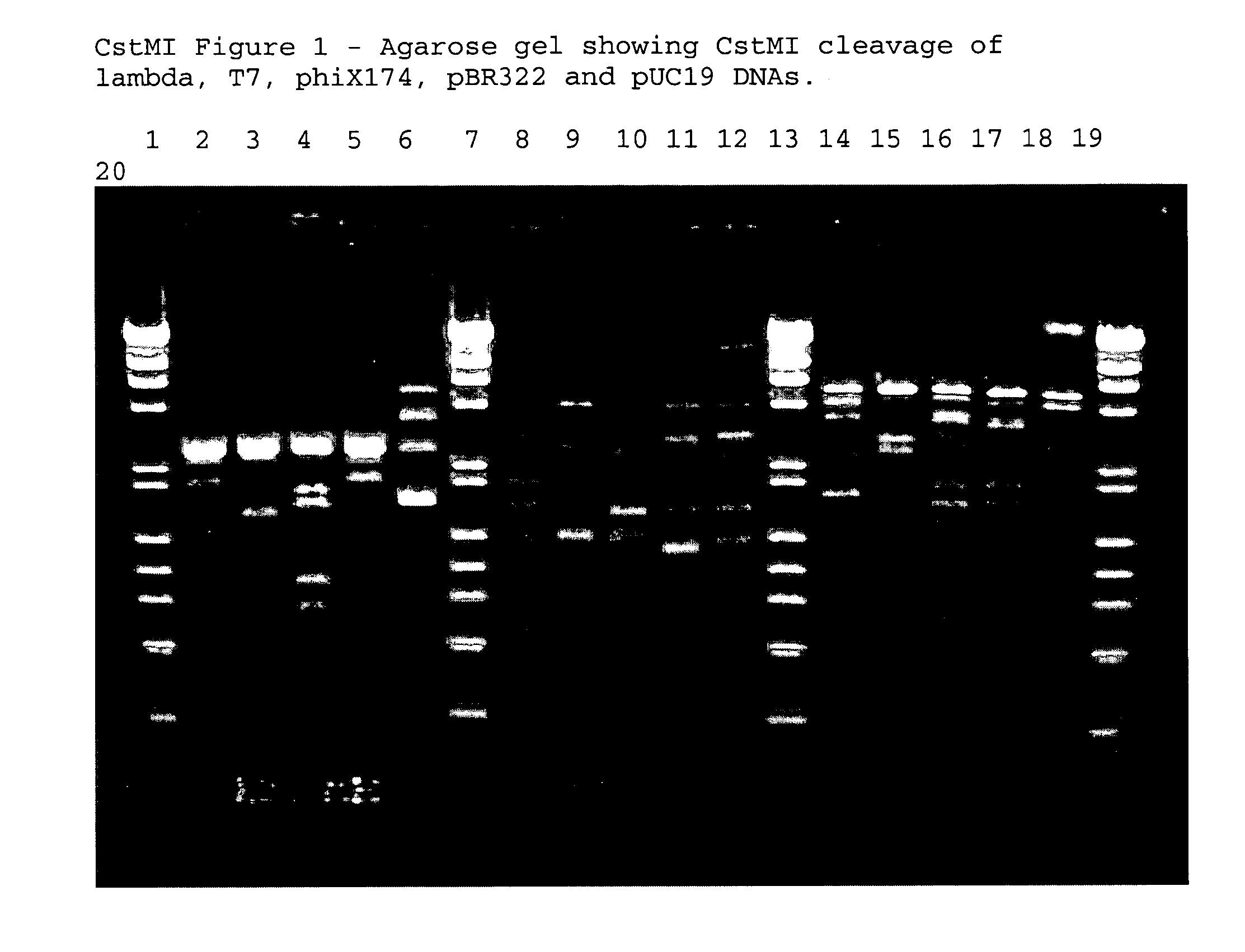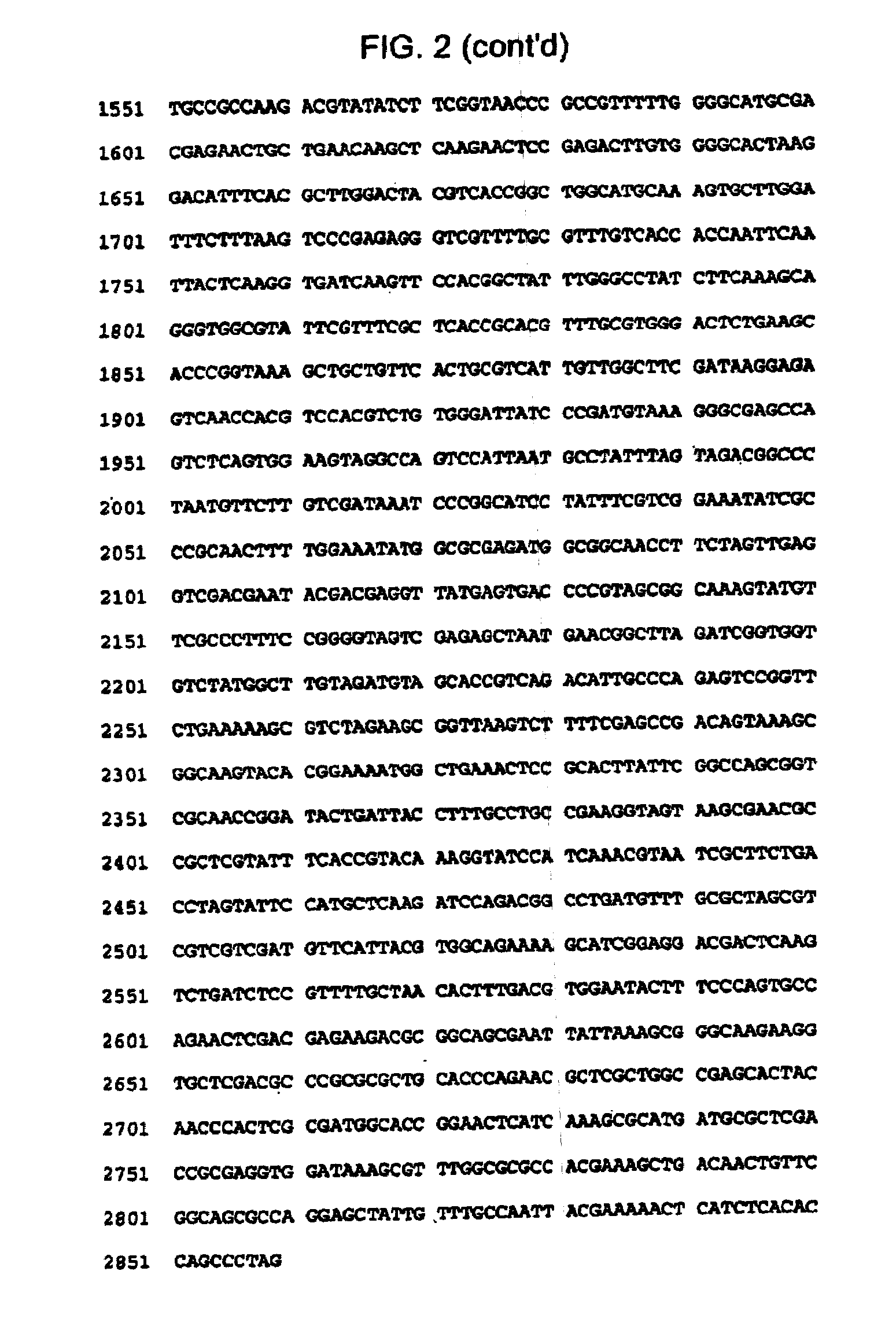Type II restriction endonuclease, CstMI, obtainable from Corynebacterium striatum M82B and a process for producing the same
a technology of restriction endonuclease and endonuclease, which is applied in the field of new type ii restriction endonuclease, cstmi, which can solve the problems of dna susceptible to further degradation by exonucleases and not being useful for genetic manipulation
- Summary
- Abstract
- Description
- Claims
- Application Information
AI Technical Summary
Benefits of technology
Problems solved by technology
Method used
Image
Examples
example i
Cloning the CstMI Endonuclease
[0035]1. Identifying the CstMI endonuclease gene from Corynebacterium straitum M82B 51,409 bp plasmid pTP10 DNA: The putative CstMI endonuclease open reading frame was identified by a BLAST search of the nonredundant sequences in the GenBank database. The BLAST algorithm was performed using the MmeI amino acid sequence as the query, with parameters of word size=3, matrix=BLOSUM62, gap costs of 11 for the existence of a gap and 1 for an extension of a gap, with no masking for low complexity. The open reading for the CstMI endonuclease, found in the Corynebacterium straitum M82B 51,409 bp plasmid pTP10 DNA, labeled gcrY and annotated as a ‘hypothetical protein,” yielded a very highly significant expectation value of E=e−171, making it an excellent candidate for a new MmeI-like endonuclease.
[0036]2. DNA purification: A DNA preparation of the Corynebacterium straitum M82B 51,409 bp plasmid pTP10 was kindly supplied by Andreas Tauch.
[0037]3. Cloning the CstM...
example ii
Production of CstMI Endonuclease
[0058]A single colony of E. coli ER2683 carrying the CstMI gene in the vector pTBCstMI.3 (NEB#1530) was grown in 2 liter of Luria broth. The cells were grown aerobically at 37° C. for 14 hours, then IPTG was added to 0.3 mM final concentration and the cells were grown for 2 more hours. The cells were collected by centrifugation, yielding two grams of wet cell pellet.
[0059]4 grams of CstMI expressing NEB#1530 cell pellet was suspended in 10 milliliters of Buffer A (20 mM Tris-HCl (pH 8.0), 50 mM NaCl, 1.0 mM DTT, 0.1 mM EDTA) and sonicated for 6 minutes at a 50% pulse to disrupt the cells. The lysate was centrifuged at ˜30,000×G for 15 minutes and the supernatant collected. (FIG. 7) The supernatant solution was applied to a 8 ml Heparin Hyper-D column (BioSepra SA) which had been equilibrated in buffer A. A 16 mL wash of buffer A was applied, then a 150 mL gradient from 0.05M to 1M NaCl in buffer A was applied and 3 mL fractions were collected. Fractio...
example iii
Determination of the CstMI Endonuclease Cleavage Site
[0063]The location of CstMI cleavage relative to the recognition sequence was determined by cleaving a suitable DNA molecule and then performing DNA sequencing from a suitable primer to the end of the cleaved DNA template. In this example pUC19 DNA and pBR322 DNA were employed as the template. These templates were chosen because there were CstMI sites in both orientations located within several hundred base pairs from standard sequencing primers. Any sequenceable DNA that has a CstMI site within several hundred base pairs of a priming site will work for this analysis, however. The pUC19 DNA was cleaved with CstMI by combining:[0064]50 μl 10× NEBuffer #4[0065]15 μl pUC19 DNA (15 μg)[0066]435 μl dH2O[0067]20 μl CstMI (fraction 28 off the MonoQ column)
and incubating for 15 minutes at 37° C. pBR322 DNA and pUC19-Adeno2 BC4 DNAs were cut using the same conditions. The cleaved DNAs were purified and concentrated using a Qiagen QiaPrep D...
PUM
| Property | Measurement | Unit |
|---|---|---|
| concentration | aaaaa | aaaaa |
| pH | aaaaa | aaaaa |
| volume | aaaaa | aaaaa |
Abstract
Description
Claims
Application Information
 Login to View More
Login to View More - R&D
- Intellectual Property
- Life Sciences
- Materials
- Tech Scout
- Unparalleled Data Quality
- Higher Quality Content
- 60% Fewer Hallucinations
Browse by: Latest US Patents, China's latest patents, Technical Efficacy Thesaurus, Application Domain, Technology Topic, Popular Technical Reports.
© 2025 PatSnap. All rights reserved.Legal|Privacy policy|Modern Slavery Act Transparency Statement|Sitemap|About US| Contact US: help@patsnap.com



